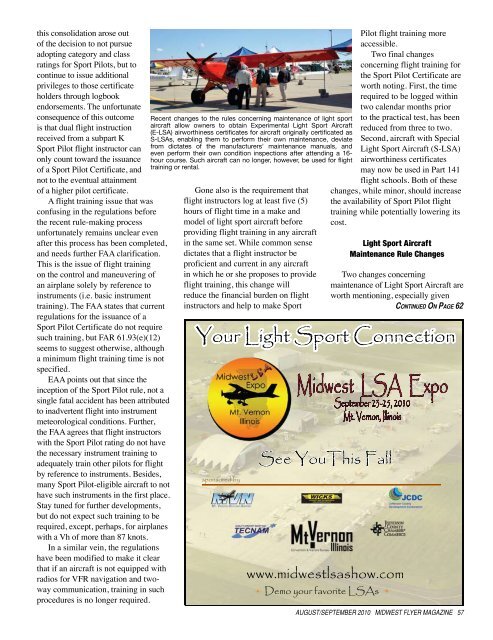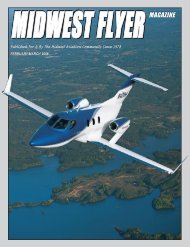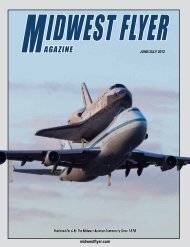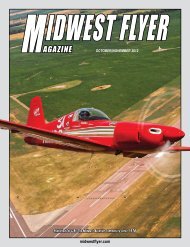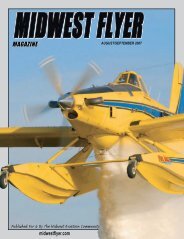AGAZINE - Midwest Flyer
AGAZINE - Midwest Flyer
AGAZINE - Midwest Flyer
Create successful ePaper yourself
Turn your PDF publications into a flip-book with our unique Google optimized e-Paper software.
this consolidation arose out<br />
of the decision to not pursue<br />
adopting category and class<br />
ratings for Sport Pilots, but to<br />
continue to issue additional<br />
privileges to those certificate<br />
holders through logbook<br />
endorsements. The unfortunate<br />
consequence of this outcome<br />
is that dual flight instruction<br />
received from a subpart K<br />
Sport Pilot flight instructor can<br />
only count toward the issuance<br />
of a Sport Pilot Certificate, and<br />
not to the eventual attainment<br />
of a higher pilot certificate.<br />
A flight training issue that was<br />
confusing in the regulations before<br />
the recent rule-making process<br />
unfortunately remains unclear even<br />
after this process has been completed,<br />
and needs further FAA clarification.<br />
This is the issue of flight training<br />
on the control and maneuvering of<br />
an airplane solely by reference to<br />
instruments (i.e. basic instrument<br />
training). The FAA states that current<br />
regulations for the issuance of a<br />
Sport Pilot Certificate do not require<br />
such training, but FAR 61.93(e)(12)<br />
seems to suggest otherwise, although<br />
a minimum flight training time is not<br />
specified.<br />
EAA points out that since the<br />
inception of the Sport Pilot rule, not a<br />
single fatal accident has been attributed<br />
to inadvertent flight into instrument<br />
meteorological conditions. Further,<br />
the FAA agrees that flight instructors<br />
with the Sport Pilot rating do not have<br />
the necessary instrument training to<br />
adequately train other pilots for flight<br />
by reference to instruments. Besides,<br />
many Sport Pilot-eligible aircraft to not<br />
have such instruments in the first place.<br />
Stay tuned for further developments,<br />
but do not expect such training to be<br />
required, except, perhaps, for airplanes<br />
with a Vh of more than 87 knots.<br />
In a similar vein, the regulations<br />
have been modified to make it clear<br />
that if an aircraft is not equipped with<br />
radios for VFR navigation and twoway<br />
communication, training in such<br />
procedures is no longer required.<br />
Recent changes to the rules concerning maintenance of light sport<br />
aircraft allow owners to obtain Experimental Light Sport Aircraft<br />
(E-LSA) airworthiness certificates for aircraft originally certificated as<br />
S-LSAs, enabling them to perform their own maintenance, deviate<br />
from dictates of the manufacturers' maintenance manuals, and<br />
even perform their own condition inspections after attending a 16-<br />
hour course. Such aircraft can no longer, however, be used for flight<br />
training or rental.<br />
Gone also is the requirement that<br />
flight instructors log at least five (5)<br />
hours of flight time in a make and<br />
model of light sport aircraft before<br />
providing flight training in any aircraft<br />
in the same set. While common sense<br />
dictates that a flight instructor be<br />
proficient and current in any aircraft<br />
in which he or she proposes to provide<br />
flight training, this change will<br />
reduce the financial burden on flight<br />
instructors and help to make Sport<br />
Pilot flight training more<br />
accessible.<br />
Two final changes<br />
concerning flight training for<br />
the Sport Pilot Certificate are<br />
worth noting. First, the time<br />
required to be logged within<br />
two calendar months prior<br />
to the practical test, has been<br />
reduced from three to two.<br />
Second, aircraft with Special<br />
Light Sport Aircraft (S-LSA)<br />
airworthiness certificates<br />
may now be used in Part 141<br />
flight schools. Both of these<br />
changes, while minor, should increase<br />
the availability of Sport Pilot flight<br />
training while potentially lowering its<br />
cost.<br />
Light Sport Aircraft<br />
Maintenance Rule Changes<br />
Two changes concerning<br />
maintenance of Light Sport Aircraft are<br />
worth mentioning, especially given<br />
Co n t i n u e d On Pa g e 62<br />
Your Light Sport Connection<br />
sponsored by<br />
<strong>Midwest</strong> LSA Expo<br />
September 23-25, 2010<br />
Mt. Vernon, Illinois<br />
See YouThis Fall<br />
www.midwestlsashow.com<br />
Demo your favorite LSAs<br />
AUGUST/SEPTEMBER 2010 MIDWEST FLYER M<strong>AGAZINE</strong> 57


